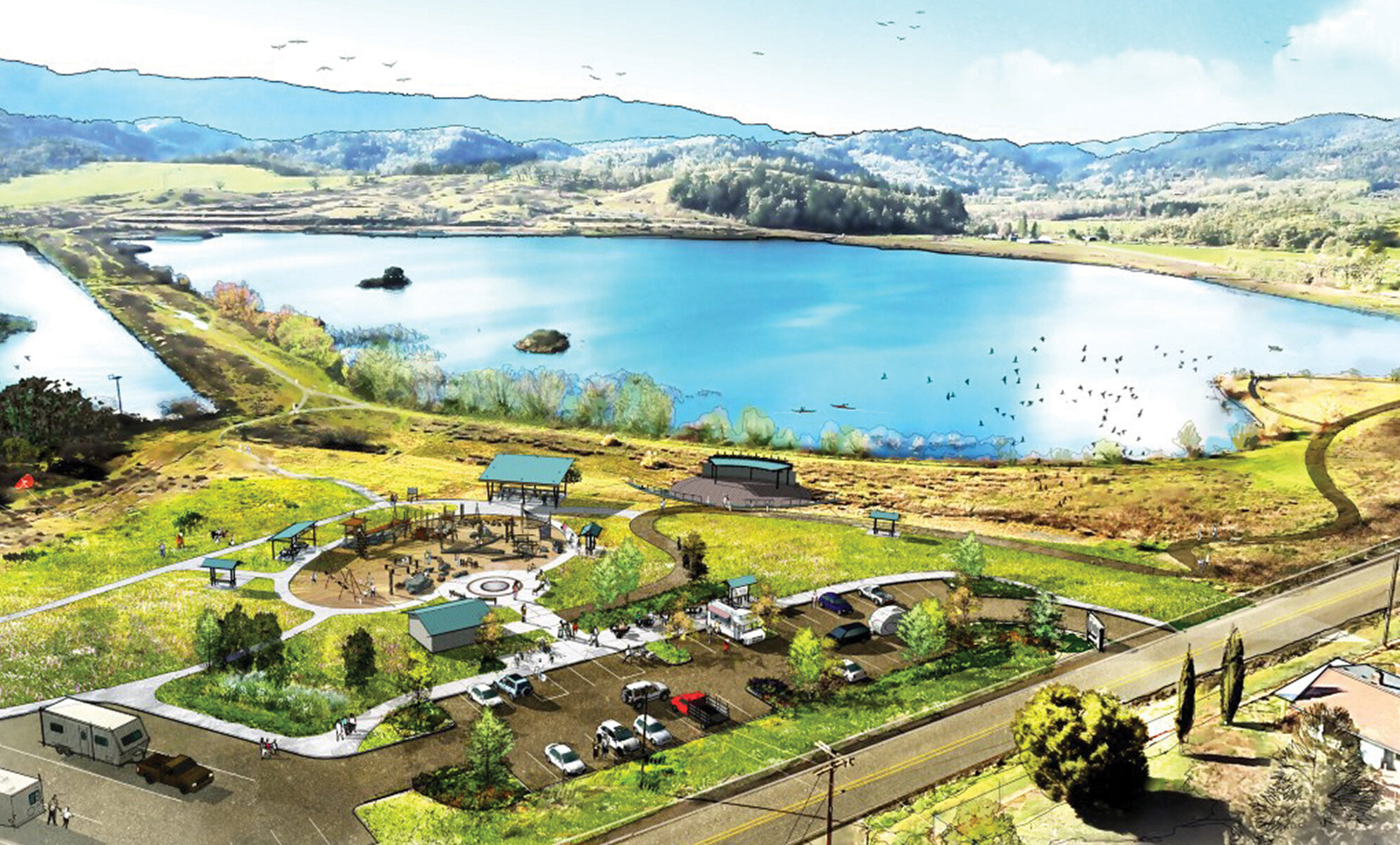Park Place

A determined Sutherlin couple sees their vision of a community park coming to life with a lot of help from their friends.
Story by Geoff Shipley Photos by Thomas Boyd
Jim and Beth Houseman are nothing if not persistent. The Southerlin couple has a vision of a new community park, but first they had to sell the idea and find some partners. So they went to work. And they persisted.
“We spent a year convincing the City of Sutherlin that a park could be out there,” Beth says.
“Out there” refers to the 202 acres of water, trees, open space and rolling hills west of Interstate 5 that had been a wheat field and log pond before being purchased by the city for water storage. Thinking the site, known as the Ford’s Pond property, could benefit the community in better ways, the Housemans started bringing local folks together to make it happen.
In 2014, the now-retired National Park Service rangers and others they had recruited to the cause believed local residents and public leaders would support their project if one significant hurdle could be overcome: funding. To clear that obstacle, they formed the non-profit Friends of Ford’s Pond.
We knew we needed funding sources other than local taxes or levies,” says Beth.
With city officials on board and some valuable grant- writing guidance, the Housemans and Friends of Ford’s Pond started seeking donations and competing for grants, largely from lottery funds available through the Oregon Parks and Recreation Department.
Jim and Beth Houseman
While competing against dozens of other Oregon communities across Oregon for slices from the same financial pie is always challenging, the Friends of Ford’s Pond were able to use the City of Sutherlin’s purchase price for the property as a grant match for six years. That was a significant advantage.
“That allowed us to play with the big boys, communities with more financial resources,” Jim says. ”We would have had to fundraise for years otherwise.”
With their grant match and a compelling project to showcase, Friends of Ford’s Pond and the city were first able to secure a grant to fund a master plan. That document would outline a long-term strategy for the park that would include not just a design vision and planned amenities, but also construction and maintenance cost estimates to guide future fundraising and volunteer efforts.
Developed in the spirit of Ford’s Pond Community Park, the 144-page master plan is a citizen-influenced vision created over a seven-month span and informed by hundreds of Sutherlin and Douglas County residents, from elementary-aged children to retirees.
“The master plan is very much informed and inspired by public input,” says Beth. “People value that their voice is heard.”
Divided into six separate phases over a prospective 10- to 20- year timeline, the plan provides a thoughtful roadmap for adding park enhancements while ensuring its inherent character is sustained and thrives. From the hillside oak savanna that’s home to hawks and deer, to the emergent wetlands and willow-lined riparian areas that provide habitat for dozens of bird species, to the 95-acre pond that hosts largemouth bass, crappie and other fish, Ford’s Pond Community Park is defined by a landscape of remarkable natural resources and scenic panoramas.
With opportunities to walk, jog, enjoy a family picnic, birdwatch, fish, kayak, paint landscapes en plein air or watch a sunset, along with a host of other possibilities for personal enrichment and relaxation, Ford’s Pond Community Park is designed to appeal to users of all ages, backgrounds and interests. During planning, the Housemans and project leaders learned that encouraging and cultivating input and support from both locals and visitors is what will keep the park flourishing for generations to come.
“In order for this park to be successful, it needs to be cared for and loved,” says Beth.
“The master plan is very much informed and inspired by public input. People value that their voice is heard.” — Beth Houseman
Since 2016, that care and love has been on full display as volunteers have worked hard to improve Ford’s Pond Community Park. That started with the removal of waist-high weeds and blackberry bushes that had overgrown much of the property and has continued with litter pick-up and additional work to improve public access. Much more is under way.
Approximately $760,000 in improvements in the first phase of the master plan have been undertaken since last fall. As early as this spring, visitors could have access to one-half of a nearly two-mile perimeter path around the pond, an expanded parking lot, new signage and temporary restrooms. Infrastructure put in place during this first phase will set the groundwork for what the plan calls for next: permanent restrooms, a covered picnic area, completion of the perimeter path and an inclusive playground for all ages and abilities.
Other planned improvements include a fishing pier, nature and wildlife viewing areas, a boat launch, interpretive signage, secondary trails, a boardwalk, wetland enhancement work and continued restoration of the native oak savanna landscape. The latter received a boost in December 2020 when local students from Sutherlin High School and the FFA program planted hundreds of white oaks that had been sprouted and nurtured from acorns gathered from existing trees on the Ford’s Pond property.
That kind of hometown support, along with volunteer maintenance staff, grassroots donations and the stewardship from Friends of Ford’s Pond, is putting this young park on course to becoming one of Sutherlin’s most treasured community assets.
And no one needs to be convinced any more about whether a homegrown park thoughtfully designed for all can really come to life “out there.”
To donate, volunteer or learn more about Ford’s Pond Community Park, visit fordspond.org.







